Mladen and Del review ‘Predator: Badlands’

Image courtesy of 20th Century Studios.
“Predator: Badlands” Starring Elle Fanning as Thia/Thessa, Dimitrius Schuster-Kolomatangi as Dek (the Predator), Rohinal Nayaran as Bud, and others. Directed by Dan Trachtenberg. 1 hour 47 minutes. Rated PG-13.
Plot summary: Dek, the runt from a litter of Yautja, must prove he’s a good Predator by executing an impossible hunt to earn his “cloak” and the respect of his Father’s clan.
Spoilers: Undoubtedly
Mladen’s take
You won’t believe what you’re about to read because it ain’t the general notion of what a Predator universe film is supposed to be. “Predator: Badlands” is – are you ready – a very good character‑driven buddy movie that’s also laden with creature roars, chitters, and screeches, lots of explosions, plenty of adventure, and doses of humor in all the right places at the right time.
Oh, the movie is about friendship and belonging and family and loyalty, too. Not the Trump administration type of loyalty where fealty is practiced by assholes to appease higher-up assholes, but loyalty to good people who are willing to stake their lives to protect you.
My God, I sound like Del. No?
You should also know that Badlands has an “Alien” and “Aliens” vibe. The bad guys work for the Weyland‑Yutani Corporation. The corporation is still in the business of harvesting, growing, breeding, etc., bioweapons as it does in the Alien movie franchise. In Badlands, it’s after the Kalisk, which is what our hero, Dek the Predator, also wants but for a different reason. Huh, wonder why Director Dan Trachtenberg inserted the evil company in the Badlands flick, which, yup, sets up a sequel.
There is nothing novel about the Badlands story‑telling foundation but the story‑telling is done beautifully.
Dek, the runt from a litter of Yautja, must prove he’s a good Predator by executing an impossible hunt to earn his “cloak” and the respect of his Father’s clan. Schuster-Kolomatangi does a good job conveying CGI Dek’s frustrations and foibles. He also does a good job speaking Yautja‑ese, which demands the throaty clicks that are used in some African languages. More important, Schuster‑Kolomatangi evolves Dek from a one‑dimensional honor‑seeking Predator to a Yautja who learns that belonging is more than trying to fulfill an imposed birthright. The family he helps build during his adventures and misadventures on planet Genna is far more important than the clan he was born to.
But, Elle Fanning as good “synth” Thia and obedient synth Thessia, is the spark that carries the film. My goodness, and this is tough to admit, Fanning is as smart, charming, and pretty as Mary Elizabeth Winstead, who stars in top‑notch movies such as “10 Cloverfield Lane.” I now adore two actresses for the same reasons. I suspect they’d be as cool and intelligent face‑to‑face as the characters they play in films.
Fanning’s Thia wanted more from life than to serve Weyland-Yutani and its AI comptroller, Mother. She saw Genna and its flora and fauna as magnificent beings in their own right better suited for study and understanding than exploitation for profit without mercy. She protected Dek even when he refused to admit he needed protection. And, she accepted Bud from the get-go, patiently but inexorably showing Dek Bud’s value as a member of their newly established clan. And that was before they realized what Bud is.
As Thessia, Fanning acted the opposite of her Thia character. Thessia was all pragmatism and programming as Weyland‑Yutani wanted. She was intimidated when she spoke to Mother (the MU/TH/UR 6000 computer system). She had no concern about deactivating and stowing her fellow synth Thia because Thia showed a tendency to think and act to the detriment of executing corporate missions.
I’ll avoid going into detail about the Badlands cinematography and sound. I’ll say this, though: Both are superb. A Dolby theater is the be‑all for action thriller sci‑fi movie watching. Man, the film looks and sounds like you’re on Genna trying to dodge plants that behave like octopus tentacles or are sharp enough to flense you. The Kalisk can re‑integrate its head with its body even after the head is severed and goes tumbling meters away.
“Predator: Badlands” is the first completely enjoyable sci-fi film I’ve seen in a long time. What was the one before that? “Shin Godzilla” from 2016. No question. Badlands is an A. How do you know I know? Because I don’t even care that Badlands is rated PG-13. And, as with “Shin Godzilla,” I’m counting the days to its release on 4K disc.
Del’s take
I’ve never understood the logic of the Predator universe.
You’ve got these aggressive sociopathic hunters who prize violence above all else, yet they possess high technology, suggestive of a more cooperative civilization. After all, it takes a village to create a shoulder-mounted blaster with triple-laser sighting, right?

If future movies elaborate on the Predator culture they should suggest the Predators we see are a caste of violent monsters separate from their more civilized brethren, like MAGA, except the Predators actually walk the talk. The MAGAts are definitely keyboard warriors and Meal Team 6.
Overall I think the Predator movies have held up well as a franchise. Others, including the endless Alien, Terminator and Die Hard movies, devolve into absurdity over time, but the Predators just keep soldiering on, even the Alien vs. Predator movies, which I thought were pretty good. The only Predator movie I can remember actively disliking was “Predators” with Adrien Brody, which struck me as a pointless bloodbath.
Every new movie seems to advance the evolution of the Predator species and “Badlands” does that to a greater extent than its predecessors. Where the creatures were solitary hunters in the past, Dek has a name and a need for companionship, though he rationalizes that need as a use of “tools.” Only later does he tacitly accept that his new “tools” have become members of his “clan.” That would be a clan of choice, a concept not lost on members of the LGBTQ community. Maybe Dek is gay! Maybe his nickname is Bubba.
It pains me to do this but I’m going to give Mladen credit for (a) accurately and effectively summarizing the movie and characterizing its content. There’s not much for me to add except, “What he said.” I didn’t see “Badlands” at a Dolby Orgasmitron thingamajiggie-equipped theater so I can’t speak to the splendid audio effects, but they sounded pretty good at my low-rent showing. And I too was impressed with the acting – I remember Elle Fanning as the insufferable pain-in-the-ass brat from “War of the Worlds” so it was nice to see her portraying a character I could get behind. I did think the pet Bud was contrived and kind of silly – that is until I found out what it really was.
Also, I was impressed by the way the writers further wove together the Alien and Predator universes. I now have a mental association between the fictional Weyland-Yutani company and Peter Thiel’s all-too-real (unfortunately) Palantir. Weyland-Yutani might have a tad more soul.
I’ll keep this short: “Predator: Badlands” is a good movie. Don’t waste it on streaming. You need to see it before it rolls out of town, even at a theater equipped with one of Mladen’s Dolby Orgasmitron thingamajiggies.
I’m giving it an A.
Mladen Rudman is a former journalist and technical writer. Del Stone Jr. is a former journalist and writer.
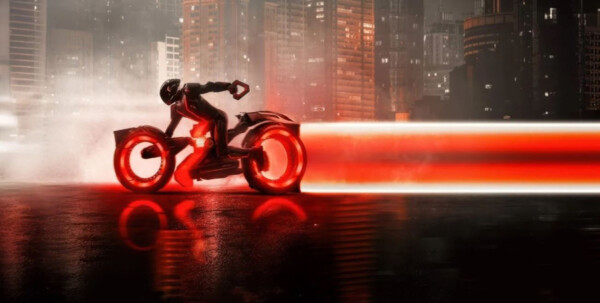
Image courtesy of Disney Studios.
“Tron: Ares” Starring Jared Leto as Ares, Greta Lee as Eve Kim, Jodie Turner-Smith as Athena, Evan Peters as Julian Dillinger and others. Directed by Joachim Rǿnning. 1 hour 59 minutes. Rated PG-13.
Spoilers: Sure.
Mladen’s take
Don’t listen to the other critics talking crap about “Tron: Ares.” It’s a good movie with a touch of heart despite the sometimes too loud Goth industrial electropunk score and its very, very vivid color palette.
I saw the film (twice) in 3D, once in IMAX and the last time in a plain ole theater. Wholly guacamole did the reds of the filmography and the Nine Inch Nails soundtrack dig deep into my brain’s sensory lobes. After, oh, 45 minutes of exposure to the pulsating everything on the screen and the raucous thumping of lows and highs coming from the speakers I got tired, if not frustrated, by the frenetic aural and visual activity. But, like the trooper I am, I persevered to see the guts of computers anthropomorphized into human forms reflecting the good and bad of our species, as well as humans being human.
Jared Leto does a good job as Ares, a program that evolves from a data‑spouting automaton following directives without question at the beginning of the film to a human-like being trying to understand the difference between right and wrong while chasing the “Permanence Code.” Jodie Turner‑Smith as Athena was a confident, menacing foil to Ares’ introspective side. She kicked ass and came back for more again and again. No “Impediment” was going to stop her from completing her mission.
Ares’ wish to “live” made it/him sympathetic. Who among us doesn’t want to stop taking orders from The Man to chase our dreams? Obedient Athena – obedient to the “user” who runs her “Grid” – is determined to fulfill her directive – find human Kim, teleport her to the Grid by deconstructing her, reconstruct her as a digital copy, and extract the Permanence Code from Kim though it will kill her. Athena’s single mindedness, if it could be described that way, is chilling.
The Ares and Athena antagonism unfolds amid a feud between corporate titan and good gal Kim, charmingly played by Lee, and corporate titan and bad guy Dillinger, effectively played by Peters, as they pursue the Permanence Code for the artificial creations their hyper‑fast, algorithm‑driven, and laser‑spewing machines produce. Permanence means that programs like Ares and Athena manifesting in the Real would survive longer than 29 minutes, the confounding limit of their life spans outside their home world. Of course, Kim wants to use permanence to feed humanity, provide health care, and develop alternative fuels. Yeah, Dillinger wants to sell permanence weapons to the military.
“Tron: Ares” is a B+. There’s no need to see it in 3D, which costs more. It just worked out that way for me. I suspect the film’s loudness and vividness was amplified by the 3D, bringing the film close to sensory overload.
Del’s take
I barely remember the 1982 “Tron” (I think I watched it drunk) and “Tron: Legacy” exists in my memory as a single image of Jeff Bridges standing atop some towering digital artifact. In truth the premise of these movies – that flesh-and-blood human beings can be digitized and loaded into a computer, then reconstituted thanks to the miracle of laser 3-D printers – is so freaking stupid I’m not willing to suspend my disbelief.
That’s weird because many of the movies I love – “The Matrix,” “Cloverfield,” “Star Wars: A New Hope” (the best “Star Wars” movie EVER and I don’t care what Mladen says) – are based on stupid premises yet I love them just the same. If I were having this conversation with a therapist he or she would want me to drill down to the real reason I don’t like them.

I think it’s because the plots are so very very standard-issue, unimaginative good-guy-vs.-bad-guy pablum we’ve seen a bazillion times in the past: Loser squares off against powerful dude – the love of a good woman is at stake – and somehow, despite EVERYTHING, the loser succeeds and becomes a not-loser, which I guess we call a winner.
That’s “Tron: Ares,” only this time the loser is a digital proprietary program that malfunctions … and develops a soul. I’m not sure how you 3-D map a soul but that doesn’t stop “Tron: Ares” and let’s just say he follows the trajectory of all these superhero and quasi-superhero movies to their inevitable conclusion. At least the Marvel movies have the decency to throw in some self-deprecating humor. None of that here.
The movie is gorgeous to look at although the digital domain, with its dominant red and black color palette, reminded me of Hell. The special effects were what you might expect from a movie who’s sole artistic virtue is special effects.
Jared Leto was wooden as Ares but then you can’t blame him – he was playing the part he was given. Really, everybody here did an adequate job of filling their roles, although Gillian Anderson and Evan Peters are always better in anything they do.
My understanding is that one of the major draws was the Nine Inch Nails soundtrack. I was expecting something on the order of Vangelis’ score for “Blade Runner,” but no, that would not be an apt comparison. Trent Reznor went all Teutonic Goth and produced a hammering, thunderous score that relentlessly beats you into a bloody, cowering pulp hiding behind your seat on the sticky floor. It’s way too much. I came out of the theater feeling like I’d gone 10 rounds with Oleksandr Usyk.
The other night I cleansed my palate with one of the greatest science fiction-horror movies of the ’60s ever made, the vastly underrated “Quatermass and the Pit.” My God, what a movie! It reminded me that good films that tell original stories really do exist in more than just concept. I hope one day to see another movie that inspires that kind of enthusiasm from me. In 2025 it seems Hollywood is more focused on churning out “content” and making as much money as possible. Art is no longer part of the equation. How sad.
Mladen was too generous in his rating of “Tron: Ares.” It’s really worth only a C+. Even the original arcade game it’s based on was better, though good luck finding a functional machine today.
By all means, see “Tron: Ares” in a theater. But bring your headphones to filter out some of the thunder.
Mladen Rudman is a former journalist and technical writer. Del Stone Jr. is a former journalist and writer.
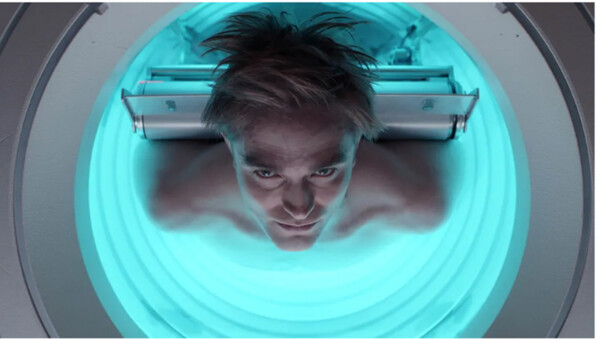
Image by Warner Bros.
“Mickey 17” Starring Robert Pattinson as Mickey “Mickey 17” Barnes, Naomi “Gonna Kick Your Ass” Ackie as Nasha, Mark Ruffalo as Kenneth “Trump Christian” Marshall, Toni “Moms for Liberty Prototype” Collette, and others. (Names in parentheses, barring Pattinson’s, ascribed by reviewer Mladen Rudman). Directed by Bong Joon Ho. 2 hours, 17 minutes. Rated R. In theaters.
Plot summary: A slave finds freedom. A love story. An allegory for the way aliens are treated by the White Man. Religion is idolatry because it’s always channeled by a pontificator who places himself above God or whatever deity a mass of people worship. Take your pick. Basically, it’s about a small-time con artist who signs up to be an “expendable,” somebody who can be cloned through 3-D printing, aboard a ship headed to the planet Niflheim. Through his deaths and rebirths he grows into something more than an expendable, as do some of the people around him.
Mladen’s take
“Mickey 17” should’ve been titled “Mickey Mouse 17,” as in something seriously malfunctioned during the planning or production of this film. I say that with a broken heart and a mound of disappointment because I adore all the other works of cinema directed by Bong Joon Ho. “The Host (2006),” my first dose of Bong, is masterful sci-fi horror tinged with political satire. “Snowpiercer (2013)” is a joyously brutal, no-holds-barred interpretation of social class warfare. “Okja (2017)” is a whimsical and realistic take on mankind’s manipulation of nature and treatment of livestock. And, yes, “Parasite (2019),” which earned the Oscar for Best Motion Picture of Year.
“Mickey 17” is a good film but, I suspect, to most people it won’t seem to be. Keep in mind that I liked the film because I have a very low bar for what qualifies as good. “Mickey 17” provoked thought and my thought was, “Why didn’t I like this film when I should have?”
The movie has all the features that I want from worthwhile cinema: Commentary on the human condition, including how easy it is for us to disregard suffering. It shows the gullibility of the masses to superstitions such as God and eternal salvation that are fired by hatred for those who are unlike us and, in this case, that includes a smart and kind alien species resembling roly-polies. The film is rife with examples of what happens when a charismatic’s horrifying decisions and actions go unchecked. Still, overall, the movie stank.

I offer this advice for watching “Mickey 17.” Make no effort to look for a master plot that links the film’s many subplots. But, if you must have coherence, think of the movie as a redemption arc for Mickey. He goes from voluntarily serving as a throwaway, literally, human being to a person whose life matters. Pay attention to the all-to-brief discussion toward the middle of the movie about “multiples.” There are other neat components in the film exploring phenomena such as 3D printing, the variability of personality even if the person is other than naturally produced, and what makes a tasty sauce for your steak. Also, Pattinson is effective portraying Mickey as Forest Gump-like and John Wick-y-ish. Ackie is very good as Mickey’s protector and a smart, big-hearted cop who cares deeply for good people be they humans or pillbug aliens. Ruffalo is good as a prosperity church preacher and Collette as the brains behind the Niflheim colonization.
For some reason, the studio, producers, or other reviewers of “Mickey 17” have labeled the film sci-fi comedy. It’s not. Yes, there are some funny parts in the movie but its murky thrust is deadly serious. The problems we now face in this age of internet squalor and mass media propaganda, mind-boggling disparities between the wealthy and middle class and poor, soulless leadership, a gullible citizenry, and willingness to drop bombs is, more or less, factored in “Mickey 17.” So is the solution. Loyalty to each other is important but that loyalty must be smart, sincere, and reversible in case what you’re loyal to ends up the source of widespread misery, if not genocide.
Huh, looks like critiquing “Mickey 17” has helped me make better sense of the movie. I urge caution, anyway. If you see “Mickey 17,” you’ll take away this or that lesson. But, to me anyway, this is a film that requires more than one viewing to comprehend its intention and sweep. “Mickey 17” treats several interesting ideas like they are drive-by-shootings, deeds that had to be done without the risk of getting caught by staying in one place too long.
“Mickey 17” has very good sound effects – plenty of explosions and an alien language that covers the spectrum from shrill howling to nearly infrasound thrumming. Visual effects are good, too. I didn’t pay much attention to the score, maybe because a lot of that attention was applied toward understanding the movie.
“Mickey 17” is either an A or an F. Can’t decide. So, for the sake of Movie Face-Off consistency and to flank Del’s punctilious need for order, I’ll split the difference to give the film a B-/C+.
Let us know what you think.
Del’s take
“Punctilious need for order”? Grrrrrrr.
YOU, sir, are the product of a “punctilious need for order,” from the protons, neutrons and electrons of your physical self to the axons and dendrites of your brain – few they may be – and the glottals and dipthongs of your often incoherent speech. Were it not for a “punctilious need for order” you would be nothing more than an amorphous blob of undifferentiated protoplasm.
In other words, Donald Trump.
But I digress. The subject here is “Mickey 17.” What I hear you trying to say is what I’ve been thinking the past day and a half: I wanted to like “Mickey 17,” I wanted to feel as passionately supportive of “Mickey 17” as I did “Parasite.” I recognize the genius of Bong Joon Ho and “Mickey 17” is a solid piece of moviemaking. But I just didn’t get into it and I’m not sure why.
I didn’t feel a visceral connection with this film. I want to say it’s lacking the manic, absurdist energy of “Parasite,” or that perhaps Bong is trying to do too much with the film, diluting its vision. Maybe I’m overthinking the whole thing.
You said the movie wasn’t funny – it tried to be funny but somehow kept missing the mark. The humor was off by about a single octave and I struggled to laugh at scenes that were obviously intended to be laughed at. You said the movie was commentary about the human condition and it was most definitely that, though not quite so on-the-nose as “Snowpiercer” or “Parasite.” Let’s talk about that for a moment.

The movie is yet another Bong denunciation of class stratifications with the 3-D printed Mickey serving as a metaphor for throwaway people. Mark Ruffalo and Toni Collette, who play Kenneth and Ylfa Marshall, leaders of the expedition to the planet Niflheim (Get it? Marshall, i.e., the law-bringer and enforcer … oh, and Niflheim is the hell of Norse mythology), represent the highest caste, followed by a pantheon of lesser gods. Mladen’s roly-poly aliens are presented as the “other,” or in Republicanspeak, undocumented aliens.
But I think “Mickey 17” is about more than just class warfare. To my age-besotted brain, it’s a carefully calibrated observation about the corruptibility of man.
Mickey Barnes agrees to serve as an “expendable” aboard a spaceship traveling to the planet Niflheim. An expendable is somebody whose body and mind are mapped and kept on file. Should they die, a new version is printed and voila, dead guy is reborn. Crewmembers eagerly assign all the dangerous jobs to Mickey because they know he can always be reprinted. He’s like a cheap TV from a big box store – if it breaks, so what? Throw it away and buy a new one.
Mickey, in effect, becomes a commodity. There’s lots of talk in the movie about commodities and the value of things, from Mickey himself to Ylfa Marshall’s weird obsession with sauces. It seems everything in life has been commoditized, which is odd when you consider the exact same conversation is taking place in America right now, from our strange obsession with the price of eggs to strip-mining our national parks and invading Greenland. If empathy is removed from the life equation, all you’re left with are cold numbers. Life becomes purely transactional. Mickey’s disposability has indeed transformed him into something like a cheap TV.
But something happened during Mickey’s reprinting. Somebody tripped over a cable and Mickey was momentarily deprived of his “ink” supply. The Mickey that emerged was not the Mickey who was originally mapped but a newer, more innocent, almost child-like Mickey who becomes an easy mark for the people around him. As Mickey “dies” and is reborn through his 17 iterations he slowly accumulates experience until, on his 18th printing (the age that people are considered grown up), Mickey is bestowed with the cynicism and corruption that characterizes the rest of us. Luckily, Mickey 17 is still around to preserve what’s good about mankind.

Or maybe that interpretation is horseshit. I don’t know. If it isn’t, I don’t think Bong anticipated life would imitate art so soon.
Robert Pattinson is a good actor who does a solid job representing Mickey in his various iterations. Steven Yeun of “The Walking Dead” fame is also effective as Mickey’s careless and uncaring business partner and “friend,” Timo. The actor who stole the show for me was Mark Ruffalo’s Kenneth Marshall, a half-baked con artist falling somewhere between Trump and Jim Bakker of PTL Club infamy. He was wonderfully bumbling.
Overall I’d say “Mickey17” isn’t as thematically coherent as his previous efforts, or if it is, it’s a lot more subtle. Bottom line? I couldn’t develop an emotional bond with the film. It’s a good movie, well worth a trip to the theater, but if you’re expecting the intensity of “Snowpiercer” and the quiet yet biting drama of “Parasite,” you may be disappointed.
People keep asking Mickey what it feels like to die. How can he answer, when he hasn’t really lived?
I’m giving “Mickey 17” a grade of B. And that’s my punctilious need for a closer.
Mladen Rudman is a former journalist and technical writer. Del Stone Jr. is a former journalist and writer.

Image by Netflix
“Squid Game” Season 2. Starring Lee Jung-jae as Seong Gi-hun, Lee Byung-hun as Hwayng In-ho, Park Gyu-young as Kang No-eul, and others. Directed by Hwang Dong-hyuk. Seven episodes, 33-76 minutes long per episode. Rated TV-MA. Streaming on Netflix.
Del’s take
Dystopian and violent, “Squid Game 2” can be seen as an intense metaphor for the rigged democracy and corrupted capitalism running amok in America today.
The original “Squid Game” Netflix series burst upon the scene in September 2021 and became an instant sensation with its dark theme of oppressed people battling each other and a faceless authority in contests where the odds were stacked against them.
In “Squid Game” deadbeats, drug addicts and gamblers whose luck has run out compete for a $31 million cash prize. What they don’t know going in is that the losers die and have their organs harvested. It’s like “The Running Man” without a quippy Richard Dawson to keep things moving along.

Lee Jung-jae reprises his role as the soulful Seong Gi-hun, who in Season 1 needed money to pay off his gambling debts and finance his mother’s medical treatments. He re-enters the game in Season 2 to bring down the organizers from within and expose the lethal abuse of contestants.
As in Season 1 the games are diabolically cruel, and it is here where “Squid Game,” as a vehicle for social commentary, takes on its shine. Games are packaged in the shiny colors and simple language of a children’s game, but nothing about “Red Light. Green Light” and “Tug-of-War” is child-like. If you don’t stop when the giant robot girl turns and opens its eyes, you die.
Meanwhile, contestants feud among themselves, trying to decide if they should continue the games or escape with their lives. That’s where Season 2 departs from the first season formula – participants vote after each game to play or go – as a group. In this outing one faction wants to continue playing, even if it costs them their lives, for the chance of winning a larger sum of money. The other wants to cut their losses and leave Squid Game island. It’s hard to ignore the parallels between that and the MAGA vs. Sane People rancor permeating American politics right now.
This season’s cast of characters includes a mother who joined to pay off her son’s gambling debts, a rapper who lost his fortune in cryptocurrency and a trans woman who needs the cash to complete her transition. Each has a story to tell and to be honest, they sound pityingly similar to the people being harmed by the current administration’s rampage through federal government services.
“Squid Game” is a dark and furious condemnation of authority and oppression, with notes of human greed and towering hubris thrown into the mix. But Season 2 departs from the script of the first season by offering a moment of hope. What will Season 3 bring? We’ll find out later this year.
Season 2 of “Squid Game” rates a grade of A.
Del Stone Jr. is a former journalist and writer.
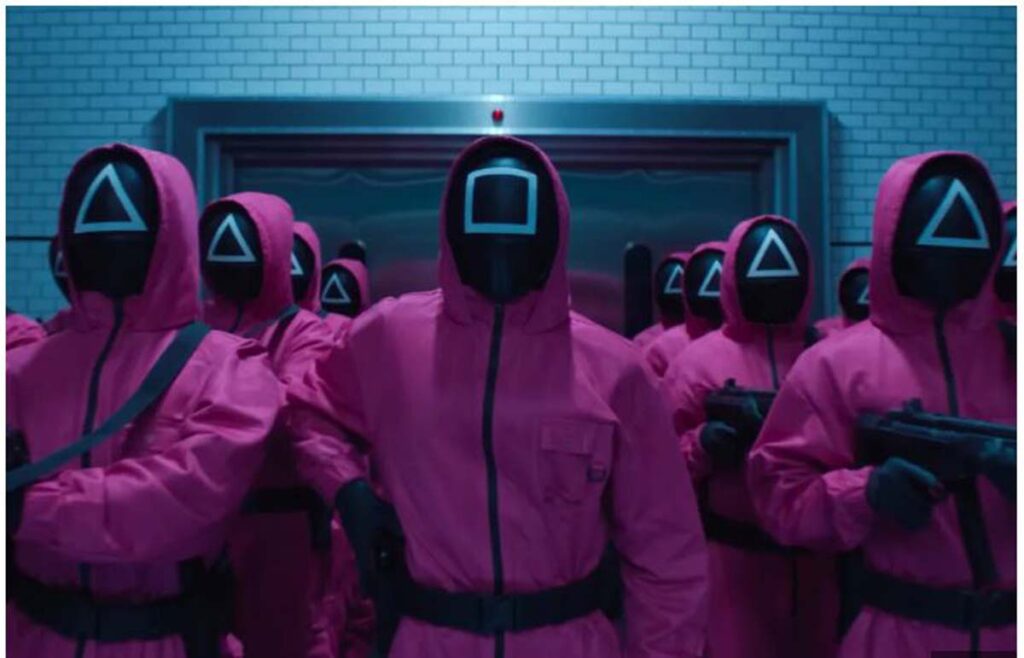
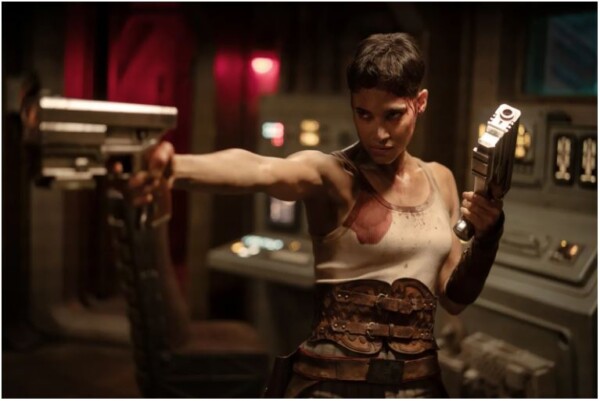
“Rebel Moon – Part Two: The Scargiver” Starring Sofia Boutella as flabbergasting Kora; Djimon Hounsou as uninspiring Titus; Bae Doona as almost likeable Nemesis; Michiel Huisman as meek Gunnar; Staz Nair as the soppy prince Tarak, Ed Skrein as the only-good-enough-character-in-the-film Atticus Noble; and others. Directed by Zack Snyder. Two hours, 2 minutes. Rated PG-13. Streaming on Netflix.
Plot summary: More of mediocre and trope-filled “Rebel Moon – Part One: A Child of Fire” but 17 minutes longer. Rednecks fight an evil empire that can’t feed the soldiers it sallies to subdue rednecks.
Mladen’s grade: C+
Dels grade: D
Mladen’s take
This is an unauthorized review. That means it wasn’t approved by Del. He wanted me to review (and, someday, I will) a movie titled “This Is Not a Test.” Sheesh, Del, are you still afflicted by your memory of the Cuban Missile Crisis? Is that why I’m supposed the review “This Is Not a Test?” Because it’s a nuclear warhead Armageddon film and you’re worried that the Small Man in Moscow will trigger World War III via Ukraine that plunges all of us into Hobbes’s state of nature.
Anyway, let’s talk “Rebel Moon – Part Two: The Scargiver” recently launched on Netflix. Two is no better than One, which is to say all the principal characters, barring one, are bland at best and unlikeable at worst. Don’t care about Kora’s faux internal conflict. Don’t care about Titus’s guilt. Don’t care that Tarak is a nepo baby trying to redeem himself. Just. Don’t. Care. That’s a problem because Rebel Moon offers nothing by way of an original story or grand ideas.
Ready for some alien invasion action? Check out Mladen’s and Del’s review of “The Tomorrow War.”
If there’s nothing pathbreaking in a film, the only factor that can save it is a good script. Neither Rebel Moons have good scripts. Two is packed with the banal such as near-immortality to keep the bad guy going, i.e., resurrecting someone from the half-cell that was saved after they’ve been incinerated, blasted apart, depressurized, I don’t know, take your pick of demises. Other banalities abound, too. Stuff like peasants fighting to keep their simple lives, peasants organizing an effective armed resistance against the system’s behemoth power, Motherworld, with two days of combat training, and peasants harvesting a massive wheat fields in three days using scythes so that they have two days to get military training before the Man arrives with a dreadnought the size of a city and thousands of troops. And, how the hell is the Rebel Moon able to produce an atmosphere, lithosphere, and hydrosphere that sustains carbon-based life when, on the horizon, is a gas giant that should be either emitting extreme magnetic radiation from its core that sterilizes everything on the moon, or locks the moon tidally so that all you get is extreme heat without darkness on one half and extreme cold without light on the other.
The secret to enjoying Two for what it is, a second-rate “Star Wars” or “Starship Troopers,” is to pay attention to the film’s few merits.
There’s the sublime evilness of Atticus Noble, the soulless admiral in charge of the Motherland force trying to sack Rebel Moon and capture Kora, who has an alias that, when revealed, surprises or shocks no one in the village. Noble is fit. Noble has a good vocabulary. Noble, who is the opposite of the meaning of his surname, keeps his uniform tidy and his composure intact as he whacks peasants and beats the crap out of Kora. Hated to see him die.
Also noteworthy is the film’s score. The music is particularly effective during Two’s last 50 minutes. In fact, just skip to the last 50 minutes of the film to immerse yourself in the spectacular visual effects. The battle scenes are terrific. Watching automatic plasma fire in slow motion fracturing and melting structures again and again never became boring. The sound is top tier, too. Everything from the zip-bang of rifles to the blast of the big gun on the dreadnought enhanced the VFX.
If you watched One, you may as well watch Two. And, yes, prepare yourself to watch Three, which is on the way. Three promises to be the all-or-nothing showdown between the Dark Side of the For … ah, between the Saviors of the Peasants and the top Motherworld Bad Guy, whose name sounds like it was ripped off from the name of a genus of dinosaur.

Del’s take
After watching “Rebel Moon Part Two: The Scargiver,” I’d like to ask, who’s the more scarred – the movie’s viewpoint character or ME, after Mladen dragged my sorry ass back into that steaming pile of wookie poop. I’ll say this about Part Two – it earned an even lower score than Part One’s dreadful Rotten Tomatoes rating of 23, clocking in at a mere 15 percent. That’s almost as shitty as Truth Social’s stock price.
Check out Del’s review of “Avatar: The Way of the Water.”
Mladen and I reviewed Part One last December and what can I say? Part Two is just as awful. OK, let me back up. It’s maybe a smidge less awful because the audience isn’t forced to suffer through the painful backstory infodump that took place in Part One. See? There is a God.
Here’s what I wrote in my review of Part One. These observations remain painfully true of Part Two:
“Rebel Moon” is Star Wars Lite, if such a thing is possible. When I saw director Snyder’s remake of “Dawn of the Dead” I told myself, “Now here’s a guy who knows how to make a movie.” Unfortunately, Snyder is a guy who knows how to make one movie. “Rebel Moon” looks just like “Sucker Punch,” “300” and “Watchmen,” and despite the lofty ambitions, it’s surprisingly bereft of depth.
Let’s not even talk about things like tropes or archetypes – “Rebel Moon” is a bad copy of a bad copy, like that photocopy of the mysterious night shift worker’s ass that turned up on the Xerox machine one morning and now everybody’s passing it around the office.
Dialogue is, well, corny. And not just corny corny, but fanboy at the science fiction convention Dungeons & Dragons icebreaker corny. Characterization is practically non-existent – you’ve seen these people in dozens of movies over the years, starting with Akira Kurosawa’s “The Seven Samurai,” the same place Snyder got the plot. It would have been hilarious if he’d ripped off J.J. Abrams. Alas, the universe doesn’t have that ironic a sense of humor. FX are not great, either. I should think $166 million would buy you a more realistic-looking spaceship or future city.
It’s all a gussied-up, overhyped pile of same-old, same-old, and I’ll be honest – it actually offends me. The science fiction genre – at least the printed-on-paper part of the genre – has thousands of really terrific stories waiting to be told. Why waste $166 million on this retread?
Are you getting the idea I really hated this movie?
I did embrace one aspect of the Rebel Moon universe – I bought two bags of Rebel Moon popcorn, but only because Walmart had them marked down to $2 apiece. And let me say, even the popcorn was crappy – chewy and stale, with lots of tooth-breaking unpopped kernels. If you want a really good bag of movie-style popcorn I recommend the AMC brand. It’s awesome. Just be sure to heat it up in the microwave for 30 seconds.
As Mladen, in a rare moment of cognitive awareness, pointed out, there actually may be a Rebel Moon Part 3. I’m telling you right now if he tries to make me watch that crap I’ll retaliate with lots of gay romance movies and a doc about the continuing evolution of the band Duran Duran. By the way, did you know they got that name from an old Jane Fonda movie, “Barbarella”? Yeah. I saw “Barbarella” at a drive-in in the early ’70s. Drunk, of course, because that’s the only way you can sit through a showing of “Barbarella.”
I give Part Two a D. It’s a goulash of clichés and horrible dialogue, and I’m angry Hollywood thinks I’m stupid enough to want that.
Mladen Rudman is a former journalist and technical writer. Del Stone Jr. is a former journalist and writer.
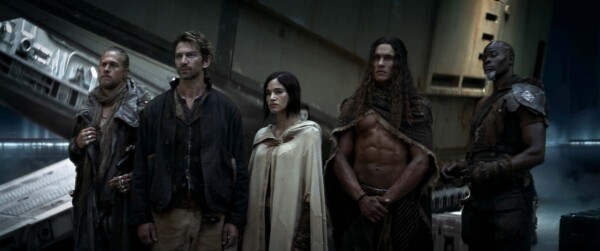
Image courtesy of Netflix.
Starring Sofia Boutella as Kora, Michiel Huisman as Gunnar, Bae Doona as Nemesis, Charlie Hunnam as Kai, Ed Skrein as Atticus Noble and others. Directed by Zack Snyder. Two hours, 13 minutes. Rated PG-13. Streaming on Netflix.
Plot summary: A quiet agrarian village on a fertile moon in a galaxy far, far away is forced to provide a Motherworld dreadnaught grain that it can’t spare. One of the villagers, the first to recognize the threat and the only one with balls though a female, scours the system for a motley crew of warriors who’ll fight the dreadnaught and its vicious commander to protect the hamlet. Part One collects the heroes who’ll resist the evil admiral and his tyrant boss.
Are there spoilers in this review: Not really.
—
Mladen’s take
What can I say about “Rebel Moon” other than it’s an OK film. I didn’t even bother watching it using my home theater.
I thought “Rebel Moon” was rated R. It wasn’t, so the violence is tame, albeit flashy, and there’s almost no cussing. No nudity, either. Shit, the film lacks grit.
The characters aren’t all that charismatic, either. Our heroine is anguished because of who she was and what she did way back when. Her train of misfits are characters we’ve all seen in the past, including the prototypical Asian as ninja.
In short, “Rebel Moon” speeds through character development so that all we’re left with are outlines of personas. There’s the displaced prince, a spiritually wounded mother, a drunken former general, and an insurrectionist who had gone soft returning to the fight against un‑motherly Motherworld.
I’m also tired of hearing the same old voices as droids. In this case, it’s Anthony Hopkins as the latent military bot J-whatever. I listen to the bot talk and all I’m thinking is that’s the king of Asgard.
Because Del is an every-cloud-has-a-silver-lining kinda guy, I’ll honor his frail tendency to try to balance good and bad by noting a couple of the film’s bright spots.
“Rebel Moon” production value is top notch. The film offers very good world building. The CGI is clean, as clean as the meld of real and fake in last year’s “The Creator.” The real people in the movie look like they are a part of the planet, moon, spaceship, city, or field they find themselves in. The creatures depicted in the movie are stylish and one smacks of Greek mythology. The other prominent critter is, oh, “Lord of the Rings-y” and good enough.
I concede that there was a scene or two that absorbed me. I was eager to see how they’d end. Unfortunately, the movie would then return to its mostly uninteresting plot. Dang, sorry about that Del. I inserted a bit of negativity into my silver lining section.
“Rebel Moon” just isn’t that good. And, it just isn’t that bad.
You want to see a very good space opera? Give Star Wars “Rogue One” a spin. Clearly, it was the inspiration, if not outright template, for “Rebel Moon.” Also better alternatives to “Rebel Moon” are “Serenity,” the 2009 “Star Trek” movie, and the new “Dune.”
Will I see “Rebel Moon: Part Two – The Scargiver?” Sure. Do I care that I must wait until the movie’s April 2024 release? Not one bit. That fact, all by itself, demonstrates my enthusiasm for the “Rebel Moon” storyline.

Del’s take
Mladen, there’s no need to be positive on my behalf. “Rebel Moon” was awful. And to think: They spent $166 million making that crap? One hundred and sixty-six million would just about cover my homeowner’s insurance and property taxes here in the “free state of Florida.”
Give me a break.
“Rebel Moon” is Star Wars Lite, if such a thing is possible. When I saw director Snyder’s remake of “Dawn of the Dead” I told myself, “Now here’s a guy who knows how to make a movie.” Unfortunately, Snyder is a guy who knows how to make one movie. “Rebel Moon” looks just like “Sucker Punch,” “300” and “Watchmen,” and despite the lofty ambitions, it’s surprisingly bereft of depth.
Let’s not even talk about things like tropes or archetypes – “Rebel Moon” is a bad copy of a bad copy, like that photocopy of the mysterious night shift worker’s ass that turned up on the Xerox machine one morning and now everybody’s passing it around the office.
Dialogue is, well, corny. And not just corny corny, but fanboy at the science fiction convention Dungeons & Dragons icebreaker corny. Characterization is practically non-existent – you’ve seen these people in dozens of movies over the years, starting with Akira Kurosawa’s “The Seven Samurai,” the same place Snyder got the plot. It would have been hilarious if he’d ripped off J.J. Abrams. Alas, the universe doesn’t have that ironic a sense of humor. FX are not great, either. I should think $166 million would buy you a more realistic-looking spaceship or future city.
It’s all a gussied-up, overhyped pile of same-old, same-old, and I’ll be honest – it actually offends me. The science fiction genre – at least the printed-on-paper part of the genre – has thousands of really terrific stories waiting to be told. Why waste $166 million on this retread?
Part 2 is coming and I could care less. I know how it’s going to end. I’ve already seen it. I don’t need to waste my time watching part 2 of a movie that scored 23 percent on Rotten Tomatoes.
Mladen’s grade: C (C- if, for a moment, the sci-fi tropes irritate me)
Del’s grade: D
Mladen Rudman is a former journalist and technical writer. Del Stone Jr. is a former journalist and writer.
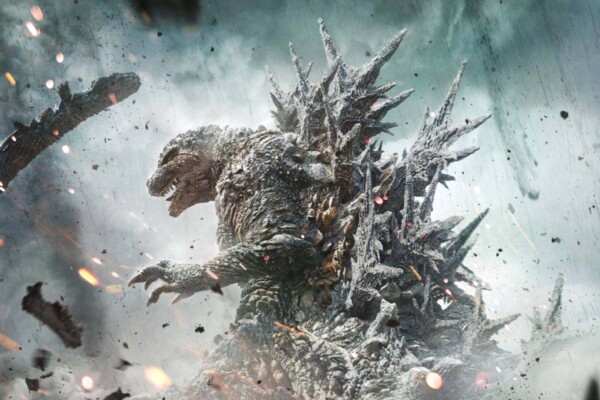
Image courtesy of Toho Studios.
Starring Minami Hamabe as Noriko Oishi; Ryunosuke Kamiki as whiny Koichi Shikishima; Sakura Ando as Sumiko Ota; Kuranosuke Sasaki as Quint, ah, Yoji Akitsu; Munetaka Aoki as Sosaku Tachibana; Hidetaka Yoshioka as Hooper, ah, Kenji Noda; and a toddler who cried as needed, among others. Directed by Takashi Yamazaki. Rated PG-13. Two hours, 4 minutes in length. Theatrical release.
Mladen’s take
“Godzilla Minus One” ain’t no “Shin Godzilla” but it’ll do. My concern is that Toho Studio’s new filmmaking philosophy is to render Godzilla movies more people-centric, rather than monster-focused, to draw more theatergoers and yen. How do I know? Because “Godzilla Minus One,” which is a crappy title for the movie, by the way, has trounced all of its other Godzilla releases at the Japanese and global box offices.
I concede that I almost fell into Toho’s people matter trap, which Del, no doubt, willingly threw himself into. Hamabe’s Noriko and Ando’s Sumiko are terrific in the film and, well, stunning, as in pretty as heck. Their presence almost offset our hero’s whimpering demeanor. All I could think about when Kamiki’s PTSD-ed former Zero fighter pilot Shikishima was on the screen was how much he reminded me of self-loathing, angst-ridden, crybaby Shinji in the “Evangelion” franchise.
“G -1.0” is a reboot of the reboot (“Shin Godzilla,” 2016) of 1954’s “Gojira.” Where “Shin Godzilla” was an innovative and imaginative rework of the heralded kaiju, “G -1.0” is a true-blue re-tell of “Gojira” down to scenes like the attack on a commuter train and a structure used by radio reporters describing Godzilla’s rampage toppling. Oh, the film’s ending is wanky, albeit intriguing.
Am I a disappointed Godzilla fanboy? No. “G -1.0” is a very good movie. When the monster appears, the action is fabulous, though derivative. Shades of “Jaws” and even the MonsterVerse’s “Godzilla vs Kong” flow through “G -1.0.” But, oh, boy, the battle between the newest Godzilla and former Imperial Japanese Navy heavy cruiser Takao is something to behold. The ship’s fate is a combination of HMS Hood, USS Arizona, and IJN aircraft carrier Akagi exploding. That scene, when I play it again and again on my home theater using a 4K disc, will be so loud that my neighbor’s will call the PD to file noise complaints. Just you wait.
Most importantly, “G -1.0” pays tribute to Akira Ifukube’s iconic Gojira score, as well as director Ishiro Honda’s vision of the monster. Hell, Tokyo’s Shinagawa ward is featured but, regrettably, there’s nary a Serizawa in the film. Still, there’s no question that you’re watching the real Godzilla, Toho’s Godzilla, rather than the non-real Godzilla, which is now that rambunctious, no-charisma, no-lineage creature of the MonsterVerse.
Yeah, go see “Godzilla Minus One” at the theater. Make sure it’s a Dolby or IMAX venue because this movie demands a sound system like no other. You Godzilla amateurs will love the people story in the film and you fanboys will get just enough G to look forward to Toho’s next release. My hope for, I don’t know, “Godzilla Plus One,” is that Toho mimics a sci-fi kaiju movie that takes its cue from Jordan Peele’s “Nope,” also somewhat of a dumb name for a film. “Nope” achieved a right smart balance between captivating humans and a fresh, big-ass monster. But it can’t be interpreted as a movie about people with the kaiju playing a supporting role.

Del’s take
“Godzilla Minus One” isn’t your grandfather’s Godzilla.
Critics and moviegoers are raving about Toho Studio’s latest iteration of the iconic lizard. Rotten Tomatoes gives it a 4.8 out of 5 rating, Simon Abrams of RogerEbert.com calls it a “well-calibrated popcorn movie,” and The Guardian says it’s one of the very best of the Godzilla series, giving it 5 out of 6 stars.
High praise indeed. So why was I so bored?
Which isn’t to say “Godzilla Minus One” is a crappy movie. It’s quite good, and Mladen, proving once again that even a blind squirrel can sometimes find a nut, rightly encourages moviegoers to see it in a theater, preferably an IMAX, to make better use of its sprawling 2.39: 1 aspect ratio. Oh, and don’t forget the Dolby surround sound.
And kudos to Toho Studios for trying to address the human quotient in its Godzilla equation, which in the past was relegated to comical stereotypes that served no purpose than to lecture the audience about whatever denunciation-worthy subject was trending at the time of filming. Don’t listen to Mladen’s crabbing about people-centric vs. monster-focused – he was long ago absorbed by an alien pod and no longer possesses human emotions.
Sure, the movie’s about a giant monster that flattens part of Tokyo. But it’s about a lot of other things, too – for instance, national identity, and the role of bushido, the honor code, in postwar Japan. The movie’s protagonist, Koichi Shikishima (played by Ryunosuke Kamiki) is a World War II kamikaze pilot who chickened out, which makes him a disgrace to himself and a traitor to his people. He lands his plane on Odo Island, where he’s exposed as a coward by members of the garrison stationed there. Later, he fails to act in a crisis and several men are killed, and his status as coward is cemented. He spends the rest of the movie trying to atone for that sin.
“Godzilla Minus One” is surprisingly candid in addressing issues of postwar sentiment in Japan vs. prewar militancy and honor, which steered me away from my traditional interpretation of Godzilla as a metaphor for the hubris of science, specifically the development of the atomic bomb. It occurred to me (maybe wrongly) that the monster could be a symbol of the United States itself, a behemoth that descends on a moral, honorable Japan and wreaks destruction without regard to who or what was deserving of such treatment.
But the movie has its problems. The first act is excruciatingly slowed by character development – not even interesting character development. I found myself propping my head on my hand, awaiting the arrival of monster mayhem. And it may be a backhanded compliment to suggest “Godzilla Minus One” is the least ridiculous of the Godzilla films but still has its moments. For instance, when the movie tries to explain the absence of America in the fight against Godzilla, it suggests the United States is fearful of a Soviet response. Apparently the scriptwriters never heard of Korea or Vietnam.
The Godzilla in this movie is an angry, muscular Godzilla, shrugging off the slow evolution that has taken place since 1954 when the monster first appeared as a symbol of Hiroshima and Nagasaki, to more recent times as Godzilla became a kind of benevolent protector from kaiju thuggery. FX are top-notch and the destruction is worthy of a Roland Emmerich film. I loved Godzilla’s radioactive breath, which set off spectacular, nuclear-like explosions. Very cool!
Also, I was impressed with Naoki Sato’s score, a perfectly calibrated synthesis of wonder and horror as the monster wreaks havoc on Tokyo’s Ginza. Yet it made room for elements of Akira Ifukube’s original “Gojira” theme, offered as a deserved homage.
Overall I’d give “Godzilla Minus One” a grade of A-. It’s an attempt to modernize the monster mythos while honoring its roots. Apart from a slow first act and a few sillies thrown in – what would a Godzilla movie be without a few sillies – it’s a good monster movie.
Mladen Rudman is a former journalist and technical writer. Del Stone Jr. is a former journalist and writer.
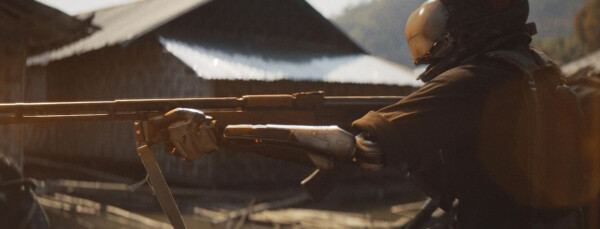
Image courtesy of 20th Century Studios.
“The Creator” stars John David Washington as Joshua, Madeleine Yuna Voyles as Alphie, Gemma Chan as Maya, Allison Janney as Colonel Howell, and Ken Watanabe as Harun. It is directed by Gareth Edwards, has a run time of 2 hours and 13 minutes, and is rated PG-13. See it in theatrical release.
Del’ take
“The Creator” did not create a box office phenomenon. In fact, it landed with a thud, earning only $30 million in its opening weekend compared to an $80 million production cost. The experts at Looper attribute its failure to the following:
The movie lacked well-known stars. John David Washington (“Tenet”) and Allison Janney (“I, Tonya”) are the two highest profile actors.
The SAG-AFTRA strike prevented the cast from promoting the film.
The film presents a sympathetic view of AI at a moment when AI technology is under fire for multiple affronts, from displacing human workers to plagiarisation and creating disinformation.
The marketing may have misled the public as to the movie’s true plot.
I would add a fifth: Meme-loving, McDonald’s-eating, Trump-voting Americans are so risk-averse they’re not willing to take a chance on an unknown entertainment quantity.
That’s a shame because “The Creator” is a decent movie. Special effects are top notch, acting is terrific, and the movie’s sweep is epic.
The plot is complicated, so bear with me: An AI entity is blamed for detonating a nuclear weapon over Los Angeles, killing millions of people and prompting the United States to undertake a pogrom to erase the algorithmic scourge from the face of the earth. A giant and impregnable space station called NOMAD orbits above a faraway land called New Asia, a haven for AI sympathizers, and blasts suspected hideouts with nuclear missiles. John David Washington’s character, a special forces dude named Joshua, infiltrates New Asia and marries the daughter of the Nirmata, or Creator, who is working to make AI even more powerful. Joshua’s mission is to identify the location of the Nirmata so that NOMAD can end the menace of AI once and for all. But Joshua’s new wife, Maya (played by Gemma Chan), is the actual Nirmata and has created a superweapon, an AI child based on her unborn baby. The child (“Alphie,” played by Madeleine Yuna Voyles), has amazing powers that could bring down NOMAD.
“The Creator” clearly has Biblical overtones and if anything, its Adam-and-Eve subtext may be too on-the-nose. It portrays AI-endowed robots as an oppressed minority who face persecution similar to that endured by Jews, African Americans and members of the LGBTQ community. The robots await the arrival of a savior who will deliver them from the persecution of Americans and the West – shades of Neo in “The Matrix.”
“The Creator’s” virtues are many. It’s a beautiful thing to look at. We saw it in IMAX and Dolby stereo, which showcased its visual and audio drama. John David Washington – who I did not know was Denzel Washington’s son! – Ken Watanabe and Allison Janney are very good in their roles. Madeleine Yuna Voyles as Alfie, the AI weapon, was excellent – this was her debut movie.
I agree with criticism the movie seems to use material from other films. At times I felt I was watching “Blade Runner,” “Platoon” or, as I said above, “The Matrix.” According to the film’s Wikipedia entry, “Edwards cited (sic) Apocalypse Now (1979), Baraka (1992), Blade Runner (1982), Akira (1988), Rain Man (1988), The Hit (1984), E.T. the Extra-Terrestrial (1982) and Paper Moon (1973) as this film’s sources of inspiration.”
“The Creator” has received generally favorable reviews from critics, who laud its spectacular special effects and grand sweep. But they simultaneously downscore it for lacking depth and heart. Said Christy Lemire on RogerEbert.com:
“Rich in atmosphere but short on substance, director and co-writer Gareth Edwards’ film has the look and tone of a serious, original work of art, but it ends up feeling empty as it recycles images and ideas from many influential predecessors.”
I’m not a Gareth Edwards fan and was unimpressed with some of his previous efforts, like “Godzilla” and “Monsters,” which I hated. But I feel I should defend “The Creator.” It’s an enjoyable science-fiction movie that at least tries to say something more than “superhero” or “Trust the Force.”
In other words, it’s not a fast-food meme, and there’s not one awful comb-over in its 133 minutes.
I give “The Creator” a B+ grade.

Mladen’s take
Strangely enough, I agree with much of Del’s “The Creator” review. The world building in this film is epic. The AI-driven simulants were fully merged with human society in New Asia. Megacities were bleak, countryside green. Cyborg and man shared everything (and it looked like it) and that produced the film’s most interesting idea, that AIs had found religion. The AIs prayed, just like humans. The AIs buried their dead or cremated them on pyres, just like humans. The AIs married each other and humans. The AIs needed a supernatural savior, just like humans.
My reaction to the notion of godliness-infused robots, which, frankly, had never occurred to me as I thought about AI? Something like this, “Holy fuck, how can beings that are supposed to be more intelligent than the critters that created them also believe there’s a ghost in the sky or a kinsman or Buddha watching over them?” My thought was all the more resonant because the only thing above New Asia with the power of Almighty was the $1 trillion space battlewagon NOMAD. Good god, God, NOMAD launched tac-nukes from an effing carousel straight down at its target, killing everything. Women, men, children, gone. Nonhuman women, men, and children, gone. Boom. Again and again. Take this and this and this, New Asia. Where are your gods when you need them most? Bah ha ha.
As Del bellyached about how little interest “The Creator” has drawn from moviegoers, I came up with an idea for a new marketing campaign. The movie is titled “The Creator,” so sell it as a creation tale extolling Creationism. “Joshua” and “Maya” are Adam and Eve because their unborn Child serves as the blueprint for a savior’s soul. What is Alphie saving? Humanity from itself. Perfect. All the world’s major monotheistic religions are dedicated to saving humans from themselves. The film’s slogan will be, “Every species needs a god.” If that doesn’t draw Del’s “meme-loving, McDonald’s-eating, Trump-voting Americans,” who also tend to be religionists, to “The Creator,” I don’t know what will.
One more thought about AIs practicing religion now that the movie has spurred me to think about it. A few weeks ago, that is before I saw “The Creator,” I developed a new definition for AI. AI does not stand for Artificial Intelligence. It stands for Apocalypse Intelligence. The AIs in “The Creator” are religionists. The “Apocalypse” is in the Book of Revelation. Duh. Of course, AI will imbibe religion. AI is already an agent of the Apocalypse, amplifying Mankind’s worst impulses and hatreds even as I write this.
One problem that Del didn’t mention is that “The Creator” is too long. Its story of undying love, redemption, hope, and the happy ending could’ve unfolded in less than 2 hours with a bit of good editing. Also, I had to keep the bile down when, amid a very cool and noisy scene featuring behemoth armored vehicles, a squad of good guys with rifles failed to hit a bad guy at near-close range. Who did the smack down? Joshua with a pistol while lying on his back protecting a wounded Alphie. God Almighty that was irritating.
But, it took no time for the film to re-envelope me with its stunning visuals after an annoying scene. This A- wonder must be seen in an IMAX or Dolby theater. The spectacle and sound are striking. I will buy it on 4K disc. I will play it at scale at home on seven speakers and a powered subwoofer but it ain’t going to be the same as the bazillion IMAX speakers and hyper-wattage that I enjoyed on a Saturday afternoon.
Mladen Rudman is a former journalist and technical writer. Del Stone Jr. is a former journalist and writer.
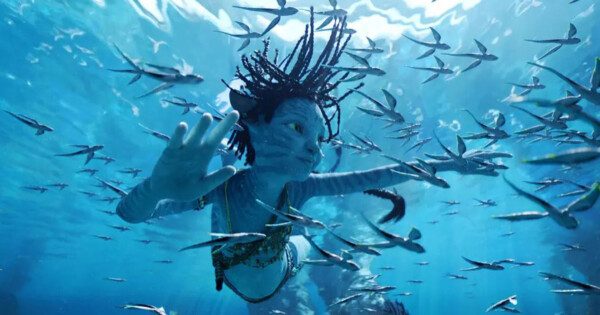
Image courtesy of 20th Century Studios.
“Avatar: The Way of Water” Starring Sam Worthington, Zoe Saldana, Sigourney Weaver and Stephen Lang. Directed by James Cameron. 3 hours, 12 minutes. Rated PG-13. Disney.
Del’s take
You will emerge from “Avatar: The Way of Water,” a changed person – a senior citizen, to be exact. It’s that long. It would take less time to read the U.S. tax code, and who’s to say which is more fun – those amortization tables can be very sexy.
If only the rest of the world loved Pandora as much as James Cameron.
“The Way of Water” is as beautiful as it is tedious, which is to say it resembles a Nat Geo documentary about the Great Barrier Reef, cleaned up and made pretty by Disney Studios. The sights are breathtaking – water with the clarity and color envied by chambers of commerce the world over, teeming with alien life. Too bad the story is the aquatic equivalent of a swimming pool at Motel 6.
These are the broadstrokes:
When we last saw Jake Sully (Sam Worthington) in “Avatar,” he had joined the Na’vi, the native race of the moon Pandora, in expelling the evil earthmen who had come to wreck their Gaia-like ecosystem in a greedy quest for unobtanium.
Now, Sully is living the life of the noble savage with his Na’vi wife Neytiri (Zoe Saldana) and a passel of kids, until one day the evil earthmen return, this time in force. They want to claim Pandora as their own because mankind has made a mess of things on Earth. It only makes sense to relocate to a planet with a poisonous atmosphere and hostile natives.
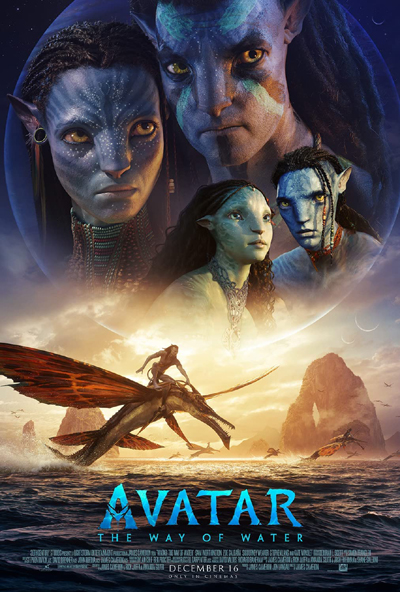
Sully leads the Na’vi in a guerrilla campaign of harassment until the earthmen introduce a new weapon – a squad of Na’vi-adapted commando soldiers led by Quaritch, the Type A head of security who was killed by Neytiri in the first “Avatar.” His consciousness has been downloaded to a Na’vi body so that he may accomplish a specific mission – kill Jake Sully.
The commandos target Sully’s family. After a harrowing close call, Sully relinquishes his forest-dwelling tribe and takes Neytiri and clan to the land of the water people, Na’vi adapted to live in Pandora’s lush tropical ocean. There, they must learn the water people’s ways and fit in – until the earthmen come calling.
“The Way of Water” is a towering achievement in both concept and special effects. Cameron has created an entire biosphere with breathtaking attention to detail, and the FX are simply the best of any movie ever made. It must be seen in a widescreen theater, although some of the bigger 4K OLED TVs may do it justice.
The story, however, is less ambitious. It is a metaphor for Europe’s arrival in the New World, told from a Native American’s viewpoint, and while it shifts in focus from act to act – at first centering on Sully himself, then enlarging to include his children and how they mesh with the water people culture, then shifting back to Sully and his antagonist, Quaritch – the overall theme remains the same: good vs. evil, and the sacrifices that must be made to serve the greater imperative. At times the Sully character deviates from the archetype established in the first film, but never fear: Events will set the character arc back on track.
Overlooking the plot, “The Way of Water’s” most mention-worthy negative quality is its length. Three hours-plus is a long time to ask an audience to sit in a theater, especially when they’ve seen so much of it before. Expect multiple bathroom trips, dozing, sneaked looks at mobile phones, and maybe a pricey box of buttered popcorn to fend off starvation pains as dinnertime approaches.
Cameron belongs to a special cadre of directors – George Lucas, Stephen Spielberg, Ridley Scott, Stanley Kubrick, John Ford, Robert Wise – who tell the big stories, and tell them in big ways. Three of the top 10 highest grossing movies of all time are James Cameron films. Undeniably he is one of the best, if not THE best, director working today. “The Way of Water” is an excellent movie, despite its shopworn plot and excessive length.
I grade it an A-, and I award the minus only because I found it to be oddly unsatisfying. Perhaps you will feel differently.
Del Stone Jr. is a former journalist and author.
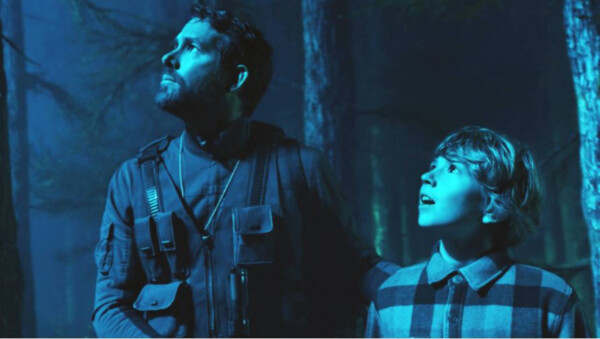
Image courtesy of Netflix.
“The Adam Project” Starring Ryan Reynolds, Walker Scobell, Zoe Saldana, Jennifer Garner and Mark Ruffalo. Directed by Shawn Levy. 1 hour, 46 minutes. Rated PG-13. Netflix.
Del’s take
“The Adam Project” is a perfectly calibrated popcorn flick that pushes all the right buttons. It features a precocious young actor who does not fear the camera, a leading man who can laugh at himself, a leading woman who is tough as the proverbial nails, and a villain as despicable as people who vote a straight party ticket.
In fact, the whole contraption is so finely tuned and calculated that I found myself missing the pop and fizz of 45-rpm vinyl, which is to say it’s a little too polished for my tastes. Oh, it’s a terrific movie and you’ll like it a lot. But the next day you’ll struggle to remember much about it except that you probably should have sprung for a Diet Pepsi to wash down the popcorn.
The story is about the titular Adam (Ryan Reynolds), who steals a spacecraft and wormholes into the past to prevent a tragedy. Unfortunately he overshoots his destination and arrives at the location and time of his 12-year-old self (Walker Scobell), whom he enlists in trying to save the future. In the process Adam bucks up his long-suffering mom (Jennifer Garner), revisits his dad (Mark Ruffalo) and reunites with his future wife (Zoe Saldana), all while thwarting the evil machinations of his former boss, Maya Sorian (Catherine Keener).
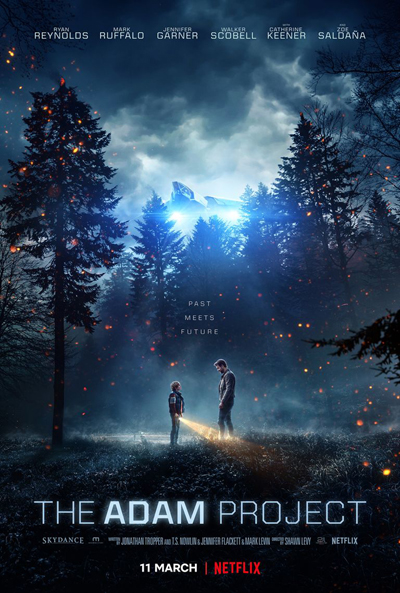
What follows is a thrill-park ride of battling robots right out of “Lost in Space,” dodging anachronisms and revisiting the good old days, none of it very demanding of deeply embedded cognitive skills. And you know what? That’s OK. Sometimes a movie is meant to do nothing more than entertain and “The Adam Project” does that and does it well, like successfully parallel parking an Edsel.
Reynolds is perfection as the wisecracking, flummoxed-when-he-should-be Adam, but more impressive is young Scobell, who matches Reynolds snark for snark and even looks like Reynolds, maybe if you squint. Garner is effective as the suffering mom, and Ruffalo is pretty funny in his role as the absent father who must re-learn his priorities if young Adam is to avoid the awful fate of growing up to become old Adam. Less effective, I thought, was Saldana as Adam’s future wife, Laura, who seems perpetually pissed-off. I mean, the fate of the world hangs in the balance and everybody’s trading witty remarks except ol’ buzz kill Laura, who just wants to stab things.
As a story “The Adam Project” keeps its focus on the action, not the novelty of time travel. “Peggy Sue Got Married” and “Back to the Future” both staked their claim on nostalgia – cars with tail fins, ’50s music and fond memories of the people who created and financed those movies. But in “Adam” nostalgia remains a sideshow to the primary conflict between Adam and Maya, and Adam’s desire to reconnect with his wife. It’s nice to see Mom and Dad getting along.
Predictably the movie has received high marks from the public. It’s one of those stories that requires nothing more of its audience than an hour and 46 minutes of their time, a big tub of buttered popcorn and maybe a healthy tolerance of the absurd. Nothing wrong with any of those things, except maybe the popcorn. Pop a Zantac and you’ll be fine.
As I watched it, however, I felt like I was taking a ride through a Universal Studios attraction, where every twist, turn and visual is calculated just so by mountains of data, algorithms and public feedback. Can you complain about a movie being too perfect? Maybe I should just shut my mouth.
I’m giving “The Adam Project” a B+. It’s funny, entertaining, and every now and again touches the heart. It’s a Diet Pepsi in lieu of champagne.
But then, who drinks champagne with popcorn?
Del Stone Jr. is a former journalist and writer.